Varutharacha Sambar is a Kerala style sambar made with a mix of vegetables, dal along with roasted and grind lentils, spices and grated coconut. Varutharacha Sambar also known as Kerala Sambar is aromatic and flavorful making it perfect to pair up with rice. Learn to make Varutharacha Sambar with step by step pictures and video.

Varutharacha Sambar is a quick sambar made by roasting and grinding ingredients along with vegetables, dal, spice and herbs. There are a lot of variations like Varutharacha Sambar Thrissur Style, Palakkad Style etc.
Jump to:
About Varutharacha Sambar
Varutharacha Sambar or Kerala style Sambar is one of the must items in Onam Sadya Menu. ‘Varutharacha’ means varuthu(roasted) + arachu (grind) roasting and grinding the ingredients differentiates this from the regular sambar. Varutharacha Sambar in simple is sambar with freshly roast and grind items.
Varutharacha Sambar is spicy, tangy ad packed with flavors. The roasting and grinding of coconut along with lentils and spices to make it a paste and adding it makes this sambar unique and flavorful. Roasting coconut along with other spices in coconut oil gives it an authentic feel.
Varutharacha sambar comes close in taste to our South Indian Arachuvitta Sambar with a slight variation in taste and the sambar consistency is thick suitable to accompany both with rice and idli, dosa.

There are a lot of variations like Varutharacha Sambar Thrissur Style, Palakkad Style etc. I usually make this sambar for lunch to accompany with rice, vegetable stir fry and enjoy the leftovers with dosa for dinner.
The roast and grind spices makes this sambar taste unique and more flavorful. Roasting coconut until golden brown is the key to a best tasting varutharacha sambar. I usually roast the lentils separately then roast coconut.
Tamil Nadu style is Arachuvitta sambar and Kerala style is Varutharacha Sambar both taste great with the freshly roasted and grind spices. Varutharacha Sambar is an integral part of Onam Sadya.

Varutharacha Sambar Video
Similar Recipes
Varutharacha Sambar Ingredients
- Vegetables – Vegetables determine the taste of this Kerala style sambar. I have used drumstick, carrot and brinjal. A wide variety of vegetables can be used for this sambar and some of them are Ash Gourd, Raw Mango, Okra, Brinjal, Ladies finger, Radish etc.
- Dal – Toor dal is rinsed well, cooked until mushy and added which forms one of the base of this sambar.
- Turmeric powder – Turmeric powder adds color and flavor to sambar.
- Onion, Tomato – Small onion is added along with tomatoes. Small onion adds more taste to sambar however you can use big onion too.
- Coconut – Coconut makes this dish a Kerala cuisine. Fresh grated coconut is recommended for this recipe as it gets roasted well and easy for grinding as a paste with lentils and other spices.
- Spice paste – Chana dal, whole urad dal, coriander seeds, fenugreek seeds, onion, curry leaves and fresh grated coconut are roasted grind to a paste and added.
- Tempering – Coconut oil is heated and mustard seeds is spluttered along with curry leaves, hing and red chili.
- Tamarind – Tamarind is mixed with water and pulp is extracted. This tamarind pulp is added to the sambar.

How to make Varutharacha Sambar
1.To begin with first rinse 1/2 cup toor dal well.
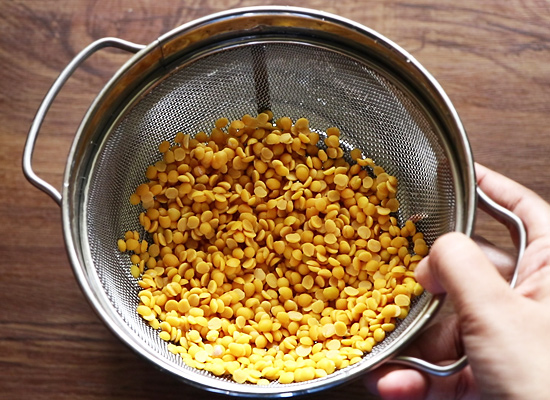
2.Add dal along with water, salt to taste and 1/4 teaspoon turmeric powder to it. Water should be at least 1/2 inch above dal.
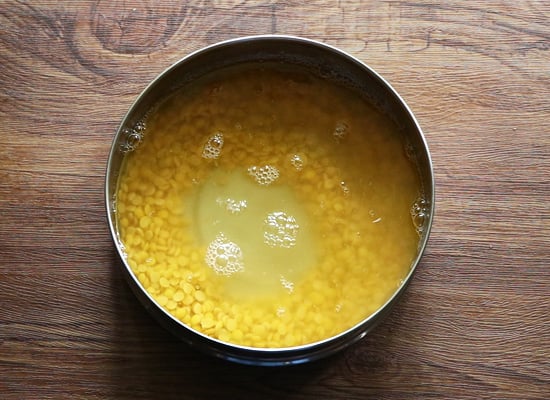
3.Add little water to pressure cooker. Keep the vessel inside the pressure cooker.
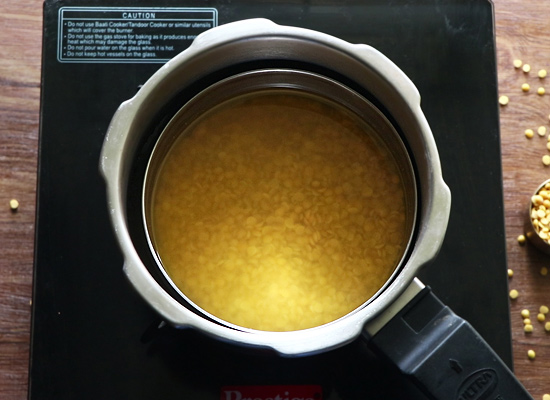
4.Close with lid. You can directly add to pressure cooker too.
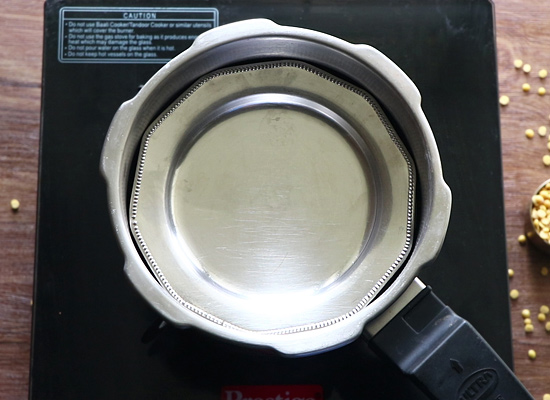
5.Cover and pressure cook for 5 whistles.
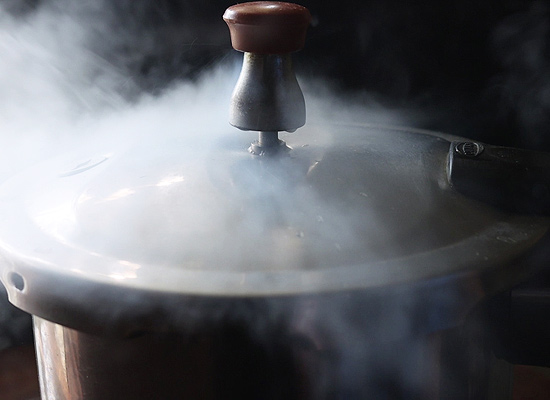
6.Let pressure release by itself. Remove the vessel.
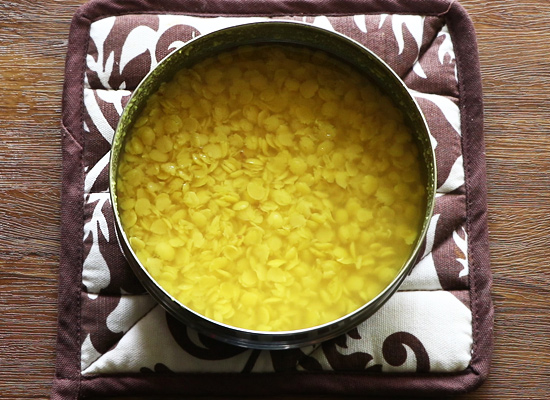
7.Mash dal well.
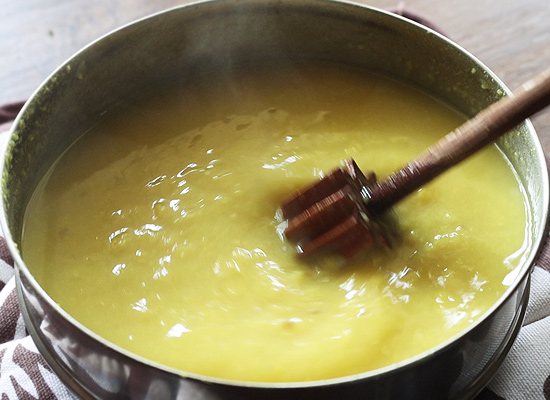
8.The consistency should be runny. Set aside.
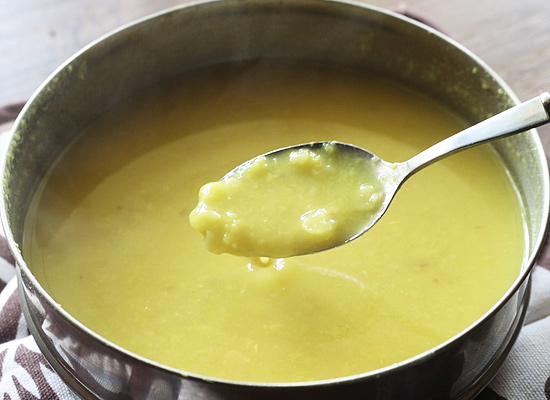
9.Heat very little coconut oil. Dry roast
- 3 teaspoon coriander seeds
- 1.5 teaspoon chana dal
- 1 teaspoon urad dal
- 1/4 teaspoon hing
- 2 nos red chillies
- 1/4 teaspoon fenugreek seeds
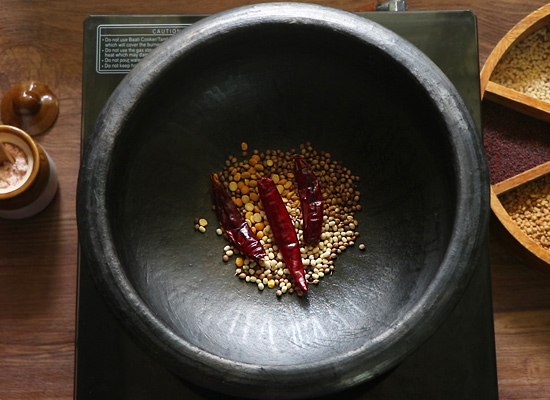
10.Roast in low flame till golden brown. Transfer to a bowl and set aside.
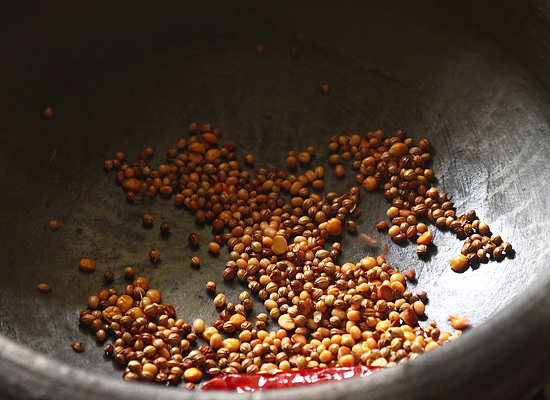
11.Then add 1/2 cup fresh grated coconut, a small sprig curry leaves, 5 small onion and hing. If you have solid hing use it, I used powdered hing.
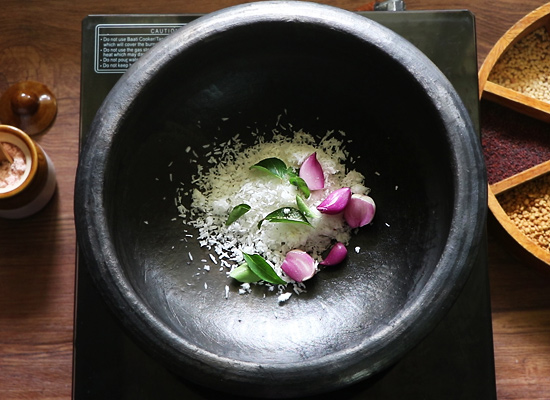
12.Then roast till nicely browned.
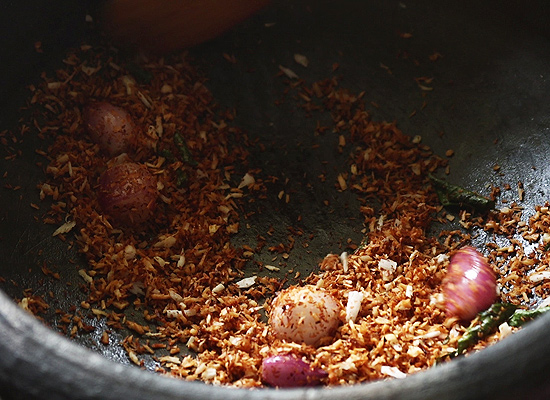
13.Transfer to a bowl. Set aside.
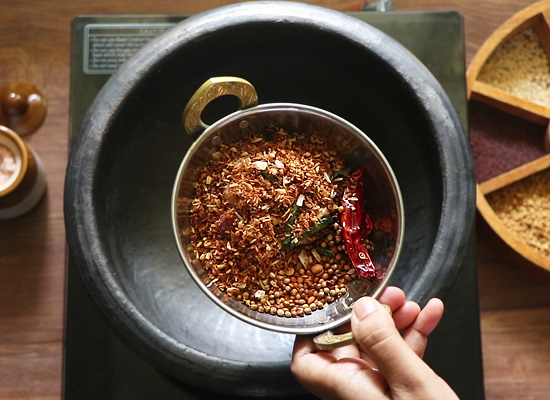
14.Add little water and grind it to a fine paste. Set aside. Varutharacha paste is ready.
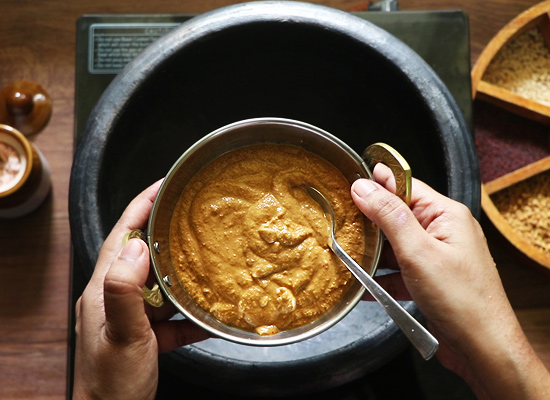
15.Add hot water to a small lemon sized ball of tamarind crush it well and set aside.
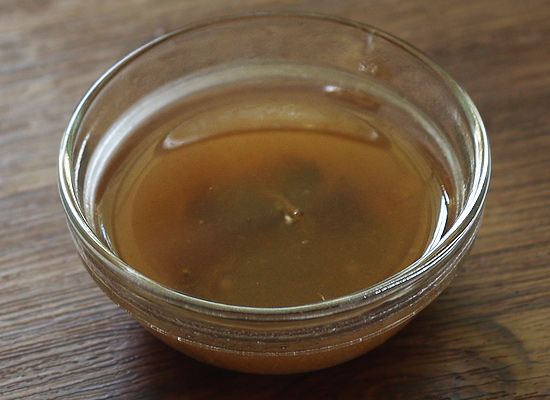
16.Heat 1 teaspoon coconut oil – Add 10 small onion,1 medium sized tomato and mix of vegetables.
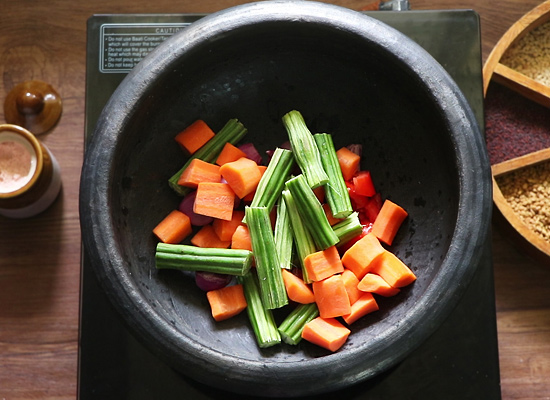
17.Saute for few minutes until raw smell leaves and vegetables shrink a bit.
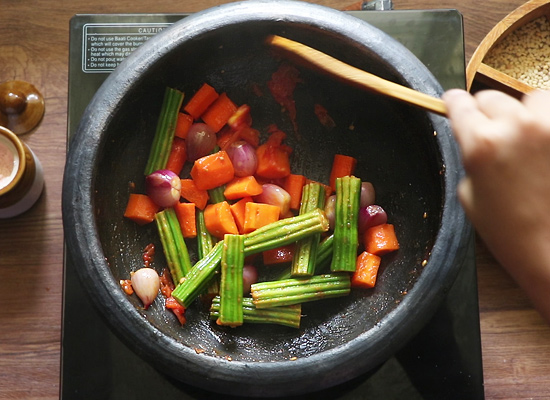
18.Add 2 cups water along with salt and 1/4 teaspoon turmeric powder.
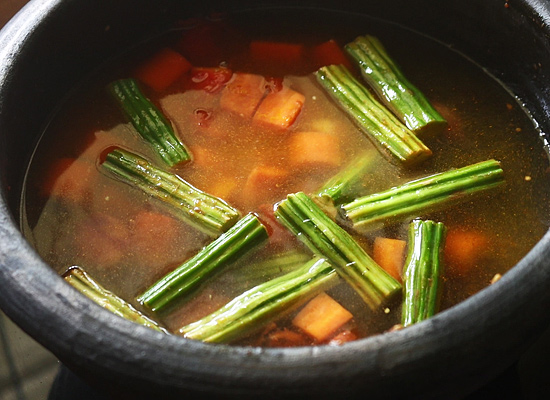
19.Let it start to boil.
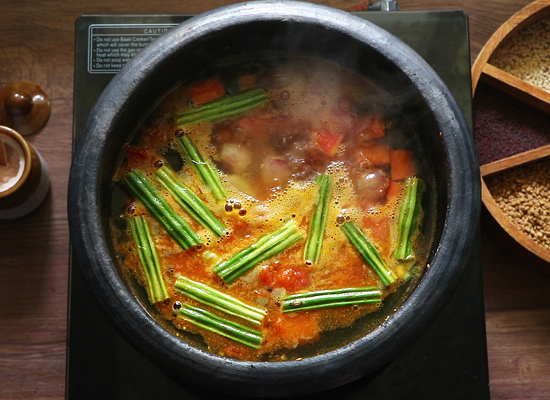
20.Cook covered for few mins until the vegetables are cooked.
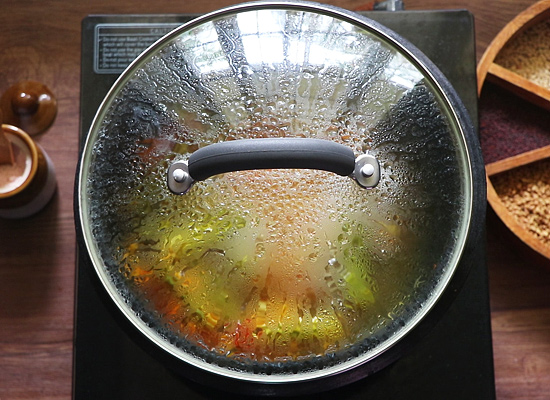
21.Check if the vegetables are cooked. If it is soft then they are cooked else cook for some more time.
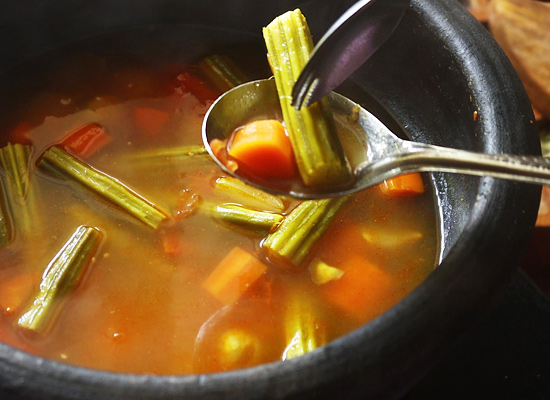
22.Add cooked dal.
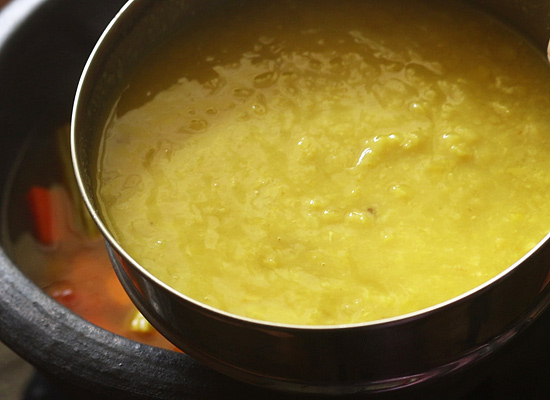
23.Add coconut paste.
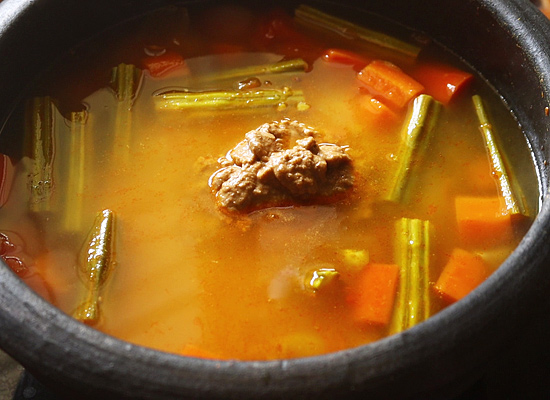
24.Add tamarind water.
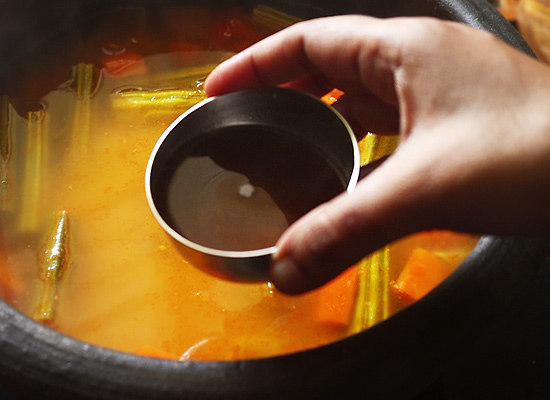
25.Mix it well. Let sambar cook in low flame. Add water if the consistency is too thick. Check and adjust salt.
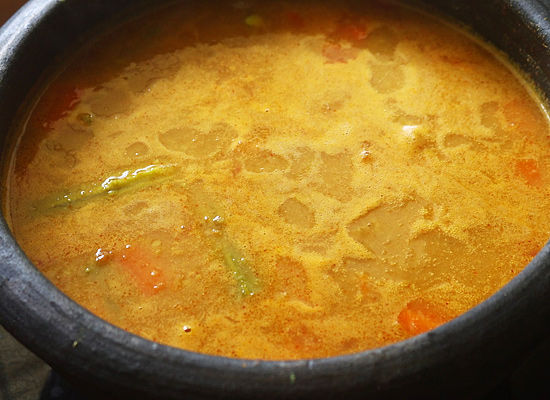
26.Let it simmer for 5-7 minutes.
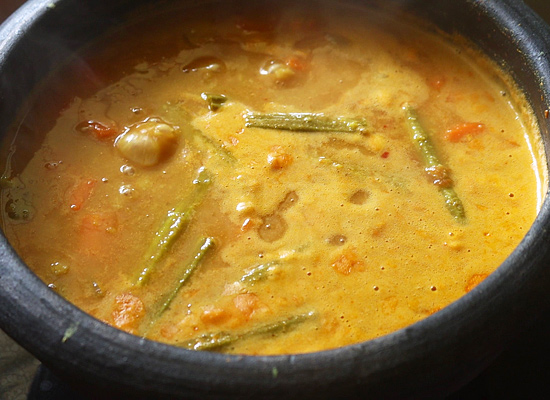
27.Meanwhile temper the items listed under ‘to temper’.
- 2 teaspoon coconut oil
- 1/2 teaspoon mustard seeds
- 1 dry red chili
- a small sprig curry leaves
- a tiny pinch hing
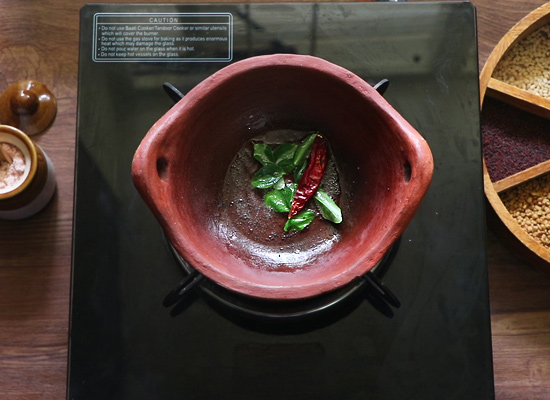
28.Add tadka to sambar. Garnish with 2 teaspoon coriander leaves and switch off.
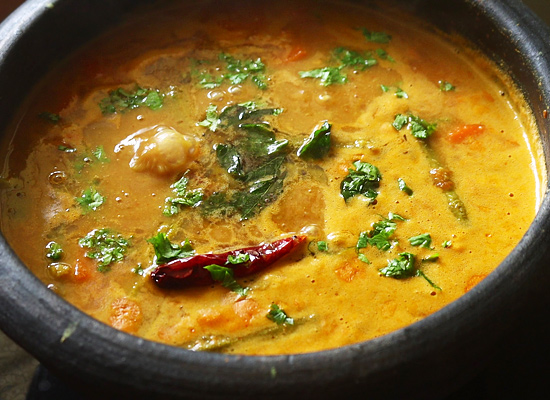
29. Varutharacha Sambar ready. Serve with rice and curry of your choice.
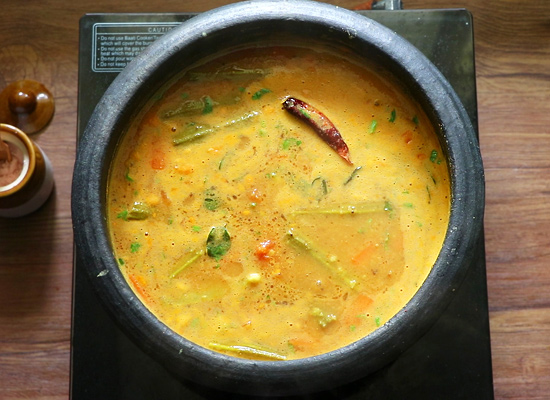
Enjoy with rice and vegetables.

Expert Tips
- After the masala paste is added the sambar tends to thicken so adjust by adding water.
- You can even add vegetables like brinjal, ashgourd, potato etc. But generally adding drumstick and carrot enhances the flavor of the sambar.
- Cook vegetables according to the tenderness of the veggie.
- Adding mixed vegetables gives a great taste to the sambar.
- The sambar is slightly thick than our usual sambar.
- You can use desiccated coconut as well when fresh coconut is not available. If grating is difficult, cut the coconut into smaller pieces, pulse it in mixer and then use.
Serving and Storage
Varutharacha Sambar is best with rice in meals. 3-4 ladles per serving in rice makes the taste perfect! It is one of the main item in the Onam Sadhya. It also goes well with Rice, Idly, Dosa, Pongal, Kichadi, Upma, Oothappam. Since coconut is used it is better to consume the same day. Use water generously with the leftovers of this Sambhar in the lunch and heat it in the evening to use it as a side dish for the night dinner.
FAQS
1.Is Varutharacha Sambar and Arachuvita Sambar the same?
Both are different, however, they are close in taste. Varutharacha Sambar is more of Kerala style – has more coconut & made as paste with dal and other spices. Arachuvita Sambar is more of Tamilnadu style – has lesser coconut & made as powder with dal & other spices.
2.Is Sambar and Varutharacha Sambar the same ?
No they are completely different in taste though both of them belong to Sambar family. As the name indicates Varutharacha Sambar has its ingredients freshly roasted & grinded while the regular sambar is a pressure cooked / steamed one.
4.What are the dishes that Varutharacha sambar goes well with?
Rice, Matta rice, Idly, Dosa, Pongal, Kichadi, Upma, Oothappam.

If you have any more questions about this varutharacha sambar do mail me at [email protected]. In addition, follow me on Instagram, Facebook, Pinterest ,Youtube and Twitter .
Tried this varutharacha sambar? Do let me know how you liked it. Also tag us on Instagram @sharmispassions and hash tag it on #sharmispassions.
📖 Recipe Card
Varutharacha Sambar Recipe
Ingredients
- 1/2 cup toor dal
- 3/4 cup vegetables chopped I used drumstick, carrot and brinjal
- a small lemon sized tamarind
- 10 small onion
- 1 medium sized tomato (chopped roughly)
- a pinch turmeric powder
- 2 teaspoon coriander leaves (finely chopped)
- water as required
- salt to taste
To roast and grind:
- 1/2 cup fresh grated coconut
- 3 teaspoon coriander seeds
- 1.5 teaspoon chana dal
- 1 teaspoon urad dal
- 1/4 teaspoon hing
- 2 red chilies
- 1/4 teaspoon fenugreek seeds
- a small sprig curry leaves
- 5 small onion
To temper:
- 2 teaspoon coconut oil
- 1/2 teaspoon mustard seeds
- 1 dry red chili
- a small sprig curry leaves
- a tiny pinch hing
Instructions
- To begin with first rinse 1/2 cup toor dal well.
- Add dal along with water, salt to taste and 1/4 teaspoon turmeric powder to it. Water should be at least 1/2 inch above dal.
- Add little water to pressure cooker. Keep the vessel inside the pressure cooker.
- Close with lid. You can directly add to pressure cooker too.
- Cover and pressure cook for 5 whistles.
- Let pressure release by itself. Remove the vessel.
- Mash dal well.
- The consistency should be runny. Set aside.
- Heat very little coconut oil. Dry roast 3 teaspoon coriander seeds, 1 and 1/2 teaspoon chana dal, 1 teaspoon urad dal, 1/4 teaspoon hing, 2 nos red chillies, 1/4 teaspoon fenugreek seeds
- Roast in low flame till golden brown. Transfer to a bowl and set aside.
- Then add 1/2 cup fresh grated coconut, a small sprig curry leaves, 5 small onion and hing. If you have solid hing use it, I used powdered hing.
- Then roast till nicely browned.
- Transfer to a bowl. Set aside.
- Add little water and grind it to a fine paste. Set aside. Varutharacha paste is ready.
- Add hot water to a small lemon sized ball of tamarind crush it well and set aside.
- Heat 1 teaspoon coconut oil – Add 10 small onion,1 medium sized tomato and mix of vegetables.
- Saute for few minutes until raw smell leaves and vegetables shrink a bit.
- Add 2 cups water along with salt and 1/4 teaspoon turmeric powder.
- Let it start to boil.
- Cook covered for few mins until the vegetables are cooked.
- Check if the vegetables are cooked.If it is soft then they are cooked else cook for some more time.
- Add cooked dal.
- Add coconut paste.
- Add tamarind water.
- Mix it well. Let sambar cook in low flame. Add water if the consistency is too thick. Check and adjust salt.
- Let it simmer for 5-7 minutes.
- Meanwhile temper the items listed under ‘to temper’ : 2 teaspoon coconut oil, 1/2 teaspoon mustard seeds, 1 dry red chili, a small sprig curry leaves, a tiny pinch hing
- Add tadka to sambar. Garnish with 2 teaspoon coriander leaves and switch off.
- Varutharacha Sambar ready. Serve with rice and curry of your choice.
Video
Notes
- After the masala paste is added the sambar tends to thicken so adjust by adding water.
- You can even add vegetables like brinjal, ashgourd, potato etc. But generally adding drumstick and carrot enhances the flavor of the sambar.
- Cook vegetables according to the tenderness of the veggie.
- Adding mixed vegetables gives a great taste to the sambar.
- The sambar is slightly thick than our usual sambar.
- You can use desiccated coconut as well when fresh coconut is not available. If grating is difficult, cut the coconut into smaller pieces, pulse it in mixer and then use.



Hamaree Rasoi
Delicious and tasty looking sambar. lovely pictures.
Deepa
bils
Great snaps… love ur receipes .. keep going
Rupa Chigurupati
Did you use fresh coconut?
SHARMILEE J
Yes I used fresh coconut…
Rupa Chigurupati
Thank you. Making today.
mamatha
Dear Sharmilee,
I made this sambar today and the smell itself took me back to my childhood days where we used to have this sambar at Ayappa pooja. It came out really good. Thank you for the recipe. One more thing my child who would be going out to start her own life I think I would recommend her your blog to follow and not to miss homemade food. You put every thing in so detail even a beginner can easily follows the steps and enjoy his/her dish. Keep going Sharmilee. Wish you all good luck.
Preeti
I make very pathetic sambar but with this recipe everyone loves the sambar that i make.Thank you so much.
Sandhya Venkatesh
Tried the recipe. The taste was very good.